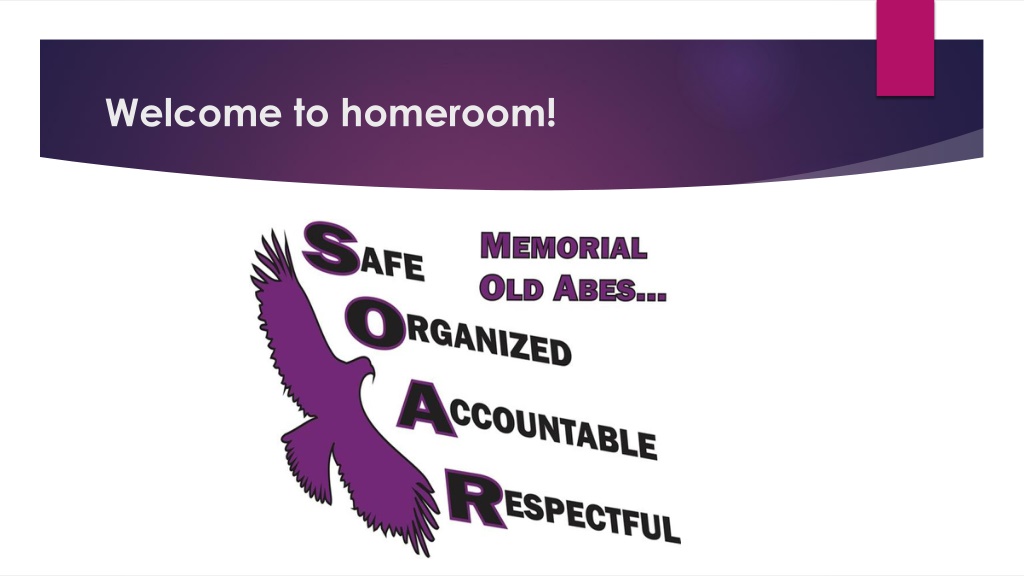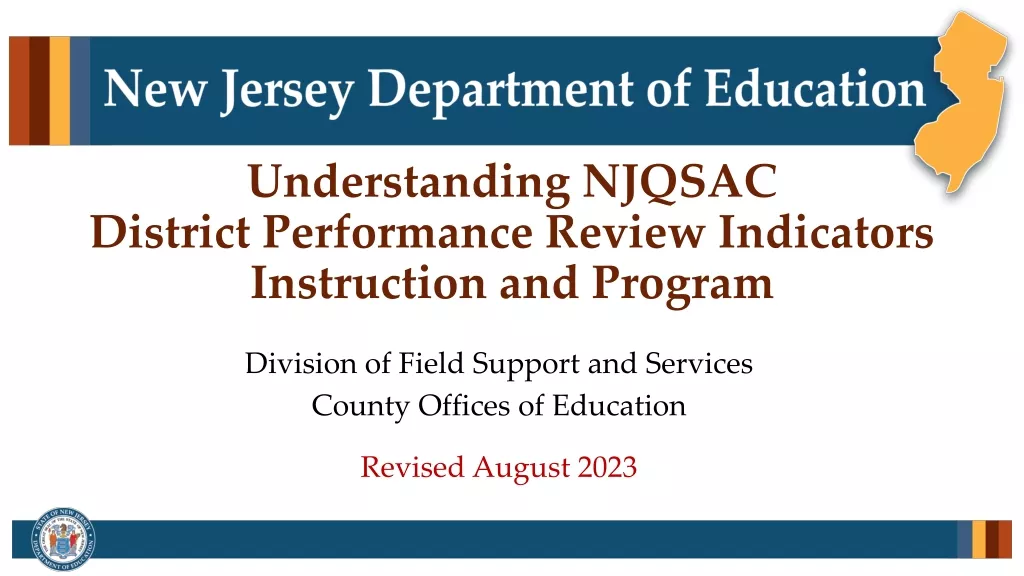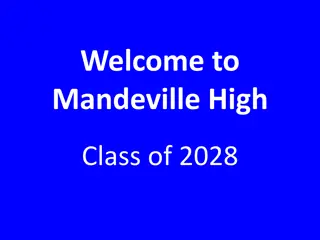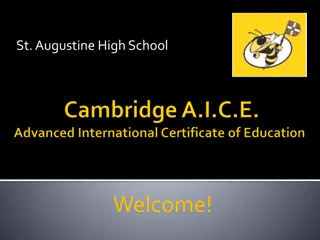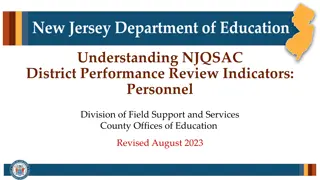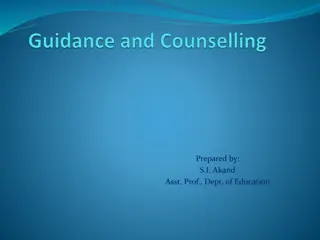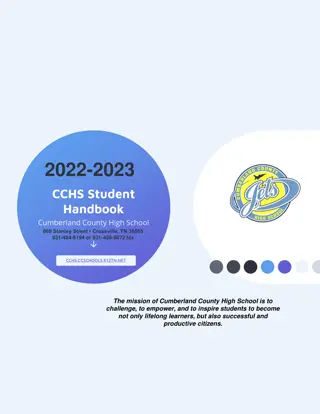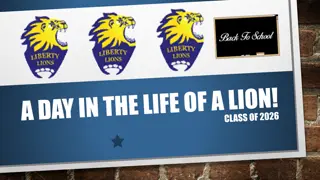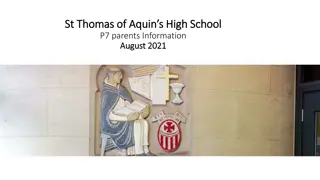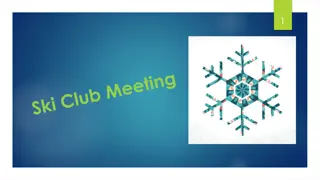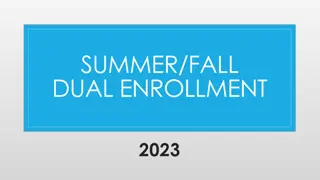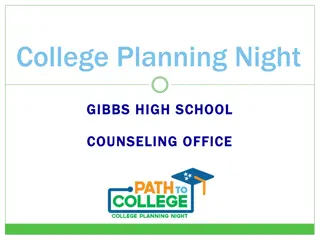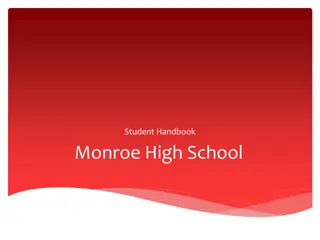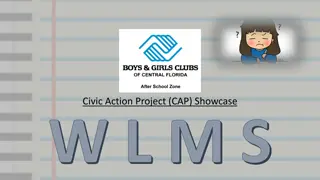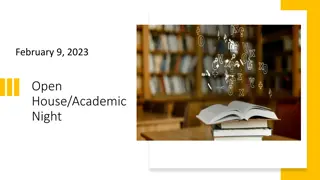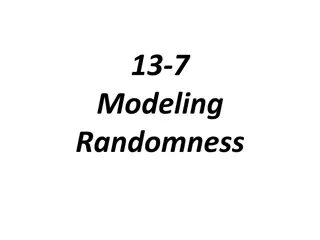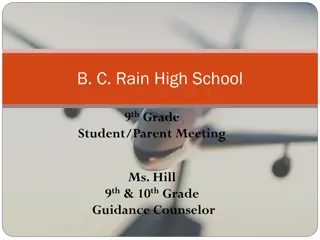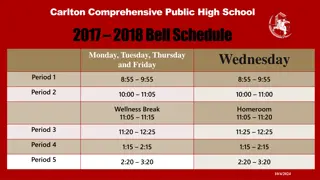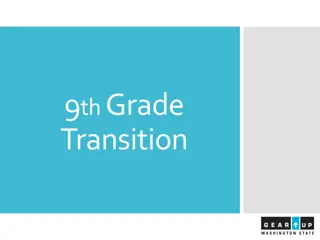Homeroom Information and Guidance for High School Students
This homeroom session provides valuable information on the school's tardy policy, SOAR matrix, positive hallway behaviors, academic and career planning options, credit options including Project Lead the Way, transcripted credits, and AP credits. It emphasizes the importance of avoiding tardiness through various strategies, positive hallway behaviors, and suggestions from seniors. The session also encourages students to explore post-secondary credit options available at Memorial High School to prepare for their academic future.
Download Presentation

Please find below an Image/Link to download the presentation.
The content on the website is provided AS IS for your information and personal use only. It may not be sold, licensed, or shared on other websites without obtaining consent from the author. Download presentation by click this link. If you encounter any issues during the download, it is possible that the publisher has removed the file from their server.
E N D
Presentation Transcript
This homeroom includes: A review of the tardy policy A review of the SOAR matrix + positive hallway behaviors Academic and Career planning options Project Lead the Way credit options Transcripted credit options AP credit options
The tardy policy revisited: STAFF-MANAGED VS. OFFICE-MANAGED Tardy: defined as not being in the classroom by the bell or fewer than 5 minutes late. If you are tardy more than 5 minutes, it is considered an unexcused absence. Excessive Tardies (3rd and each successive tardy per semester) 3rdTardy : Issue a lunch detention 4 + Tardies: Administrative decision 1st Tardy: Please reteach behavior in a positive manner. 2ndTardy: Reteach behavior and inform student of future consequences. 3rdTardy + each successive tardy per semester: Please fill out the MHS Behavior Tracking Form and submit to office.
How do you avoid being tardy? MHS student have produced a short video with strategies to avoid being tardy + examples of positive hallway behaviors: G:\MHSStaff\PBIS\Videos\hallways 24p.wmv What are examples of things you can do to avoid being tardy or positive behaviors that you observed in the video?
Suggestions from seniors Plan your route + take the most efficient path. Know where water fountains, bathrooms, etc. are located. Keep to the right and move at a quick pace. Pull over to the side if you want to talk in groups of two or more. Pull over to text or use the phone if you are walking between classes. Please talk with an inside voice between classes. Please have a hallway pass with you if in the hallway during class. Please speak quietly/whisper if you are in the hallway during class.
Suggestions from seniors Please do not swear. Put trash in the garbage. Be modest with displays of affection in the hallways. **Lunch: Please remain downstairs for lunch in the commons and go upstairs only 5 minutes before your class. Please do not stand outside of a class that is in session during lunch to talk. Move to another location. Open doors: Door 4 is open all day. Door 13 + 15 will be open during lunch.
Earning Post Secondary Credits in High School A key component to the ECASD Post Secondary Readiness plan is to prepare students for post-secondary academic work. Part of this plan includes offering college level courses to high school students. Research shows that freshmen at post-secondary institutions that have taken college level courses in high school are more likely to continue on to their second year of post-secondary education and earn a high GPA. We encourage you to look at and consider all of the options available at Memorial . Then we want you to take a risk and try one of these post-secondary options. VIDEO Link
Project Lead the Way (PLTW) Project Lead the Way (PLTW): PLTW is a national pre-engineering program designed to give students the opportunity to apply math and science skills as they explore the broad field of engineering. Classes focus on team problem solving and are project-oriented using state-of- the-art technology. Classes Include: All are 1.0 ECASD credit Digital Electronics Principles of Engineering Introduction to Engineering Design Computer Integrated Manufacturing Civil Engineering and Architecture Engineering Design and Development
Project Lead the Way (PLTW) Successful completion of a PLTW class includes: A grade of B or higher in classroom course work A completed course portfolio A stanine score of 7 or higher on the end-of-course exam Project Lead the Way course credits are transferrable to both 2 and 4 year colleges. Each institution s admissions office has procedures for receiving, reviewing, and accepting the transfer credit.
Transcripted Credits with Chippewa Valley Technical College (CVTC) Transcripted Credits with Chippewa Valley Technical College (CVTC) through Youth Options These are actual CVTC courses taught by ECASD staff at Memorial High School. Students must sign up for the class and will also register with CVTC at the start of the semester to receive transcripted credit. There is no cost to the student. ECASD course ECASD credits CVTC course CVTC credits Accounting III .5 Accounting I 4 Microsoft Office Suite .5 Microsoft Office Suite 2 Entrepreneurship .5 Introduction to Business 3 Biotechnology .5 Nano Cell Biology I 3 Personal Finance .5 Personal Financial Planning 2
Transcripted Credits with Chippewa Valley Technical College (CVTC) Course credits are transferable to both 2 and 4 year college programs. Each institution s admissions office has procedures for receiving, reviewing, and accepting the transfer credit. Students can opt out of the CVTC credit arrangement at the end of 10thweek of the semester, as these grades become part of the student s collegiate record. Other courses being investigated as transcripted credits include: Construction I, Photograpy1, Parents and Children, and Assistant Child Care Teacher.
Advanced Standing with CVTC Chippewa Valley Technical College offers opportunity for high school students to earn advanced standing transfer credit. Students who complete the approved secondary course(s) with a final grade of B or better will earn advanced standing credit at CVTC without paying additional fees. These credits are claimed at CVTC only upon admission to CVTC. There are no collegiate grades awarded to the student, so this does not affect the student s collegiate GPA. The student s credits may be transferable to other technical colleges who have the same program. Some four-year institutions will accept these credits through transfer, including UW- Eau Claire, UW-River Falls, and UW-Stout. Students should consult with individual institutions for credit acceptance.
Students completing these CVTC courses will earn the designation of (AS) on their ECASD transcript, noting Advanced Standing Some of these courses have pending Transcripted Credit agreements as well. ECASD course ECASD credits CVTC course CVTC credits Veterinary Science I Veterinary Science II 0.5 0.5 Animal Science 3 Marketing I Marketing II Classroom Component 1.0 1.0 Professional Selling 3 Marketing I Marketing II Classroom Component Marketing II Internship 1.0 1.0 Marketing Principles 3 1.0 Parents and Children Careers with Children (ACCT) 0.5 0.5 Foundations of Early Childhood Education 3 Veterinary Science I Veterinary Science II 0.5 0.5 Animal Science 3
Advanced Standing with Art Institutes International Minnesota (AiM) The Art Institutes International Minnesota (AiM) offers an opportunity for ECASD Photography I and Photography II students to earn four credits for the AiM course, PHI1401, Principles of Photography or PHI1402, Principles of Digital Photography. The agreement requires that students: Complete Photography I or Photography II with a final grade of B or better. Meet the admission policy requirements of AiM and be admitted as a degree- seeking student within 15 months of high school graduation. ECASD course ECASD credits AiM course AiM credits Photography I 1.0 Principles of Photography 4 Photography II 1.0 Principles of Digital Photography 4
Youth Options This program allows 11th+ 12thgrade students to enroll in 1 or more courses at a UW campus or center, a technical college, or a private nonprofit college located in the state. Students must meet the entrance requirements of the institution. Only courses that do not duplicate ECASD course work may be approved. A post-secondary course approved for high school credit shall be granted 0.25 credit per 1 semester credit offered by the post-secondary course. the school district is required to pay the actual cost of tuition, fees, books + other necessary materials. If a student fails or withdraws from the class after the allowed drop period, the district will request reimbursement from the parent. If a student receives a failing grade in a course or fails to complete the course, the student s parent/guardian or the student, if an adult, is responsible for reimbursing the district for payment of the tuition and fees paid by the district. Applications for enrollment must be made by March 1 for the fall semester, and by October 1 for courses to be taken during the spring semester. Information regarding the process and procedures is available in the Student Services Office.
Advanced Placement (AP) Program The AP Program is a cooperative educational endeavor provided by the College Board for secondary schools and colleges/universities. Provides an opportunity to earn college credit. (All UW institutions and many colleges and universities in the country offer credit for scores of 3, 4, or 5 on AP exams. Over 1200 colleges and universities offer up to one year s credit, or sophomore standing, to students presenting qualifying grades on the AP exams.) Provides an opportunity to participate in college-level challenges while still under the guidance of supportive high school staff. Compares abilities in a variety of disciplines with other students in the nation and world. Assesses skills in a variety of discipline areas to assist students to better prepare for the future.
Advanced Placement (AP) Program Costs of the Advanced Placement (AP) Program I AP Exams, given in May, are approximately three hours in length. The 2015-16 student test fee will be $92 per exam. The standard fee for a test ordered, but not taken, is $20. The College Board has initiated a fee-reduction policy for low-income students. Students who receive free or reduced lunch will receive a fee waiver.
Advanced Placement (AP) Classes Post- ECASD Credit(s) Post-Secondary Course Name Secondary Credits ECASD Course Name 0616: AP English Language & Composition 0618: AP English Literature & Composition 0724: AP Statistics 0726: AP Calculus AB 0728: AP Calculus BC 1126: AP Biology 1134: AP Chemistry 1142: AP Physics C: Mechanics 1144: AP Physics C: Electricity & Magnetism 1202: AP United States History 1206: AP European History 1210: AP United States Government and Politics 1216: AP Macroeconomics 1220: AP Psychology 0236: AP Studio Art-Drawing 0836: AP Music Theory 1.0 1.0 1.0 1.0 1.0 1.0 1.0 1.0 1.0 1.0 1.0 0.5 0.5 1.0 1.0 1.0 See post-secondary institution for their credit acceptance policy, and their assignment of specific course title and number of credits. Course title and credits may depend on the student s AP test score.
Academic Career and Planning for Post Secondary Success When registering for 2016-2017 classes, we encourage you to take a risk and take one of the many classes that offer both ECASD and post-secondary credit.
